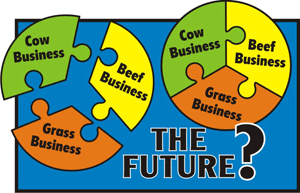
Kris Ringwall
Beef Talk
The future of beef, cows and grass
One fundamental point often is overlooked among all the charts, trends and rhetoric about the beef business. The beef business does not exist without the business of the cow. The cow business is the foundation of the beef business. Without cows, there is no beef or beef business.
Perhaps the more appropriate title for future discussions should be the future of the cow business. Having said that, let us return to the future of the beef industry discussion and recap a bit.
The beef industry is dependent on many, many scenarios. As each scenario plays simultaneously with other scenarios, a new beef industry slowly evolves. The individual scenarios, at least those defined in the fall of 2006 by the American Agricultural Economics Association and published as a discussion in its Choices journal (www.choicesmagazine.org/2006-3/2006-3.pdf), focused on seven issues that affect beef. The issues are:
• Markets, structure and competition
• Value in integrated markets
• Increasing demand
• Environmental regulation and litigation
• Immigration and labor
• Animal identification and traceability systems
• Community impacts
Does one issue overshadow another, or is one issue more important? The answer is "probably not" because the beef business will not function without completeness. The failure of any particular segment will affect the rest of the business negatively.
That might be why cows suddenly take the stage when one gets to the discussion of the environment. I may be wrong, but there tends to be an underlying assumption that the animal industry will continue to become more concentrated and specialized. This may or may not be true, but there are impacts either way.

Perhaps here is where we need to switch gears a bit and differentiate between the future of the beef industry and that of the cow business. One of the current concerns that has the beef industry challenged is the decrease in cow numbers. In other words, concerns about the cow business.
The cow business passes the baton to the beef industry when the calf is sold. At least that is how many would perceive the process. Often, if one looks at groups that are discussing the future of the beef business vs. groups that are discussing the future of the cow business, one does not see a huge overlap in membership of the discussion groups.
One could go a step further and stop by a group discussing the future of the grass business and be even further distanced in membership. Cows consume grass, so the future of grass is vital to the future of cows, and the future of cows is vital to the future of the beef industry. In other words, as the baton is passed between segments of the industry, at least a good understanding of the previous industry is needed to have a good future discussion.
Environmental issues directly hit the cow business in more ways than often is perceived in the beef industry. For generations, the cow business has strived to raise cows despite the constant weather problems. It has not been easy.
In the northern environment, winter was an obstacle, so up went hip roofs. The daily chores were very labor-intensive because the gutter had to be cleaned daily to assure the proper disposal of all the animal manure. The cow has not changed, and the daily output of manure is no different today than when the homesteaders integrated accepted old-country practices in dealing with animal husbandry.
In addition to the housing needed to deal with the elements, most operations utilized nature's hills and valleys so the cows could take advantage of natural shelters. As time went on and the neighbors left, the herds started to get larger and outgrew the hip-roof barns. The barns were replaced with pole sheds that were mechanically cleaned periodically.
In today's cattle operations, many cows never see any significant shelter other than what a good grove of trees or a coulee can provide.
The problem is then different for the grass industry, cow industry and beef industry. Environmental concerns are not always the same or always concerned with concentration and specialization.
For example, the grass business accepts harsh environments, while the cow tries to avoid harsh environments. Meanwhile, the beef industry tries to design away harsh environments.
 If one keeps score, there is no apparent winner. More later because the future does exist.
If one keeps score, there is no apparent winner. More later because the future does exist.
This article is the sixth in a series of articles focused on the future of beef. For previous articles in the series or to comment, visit www.beeftalk.com. For more information, contact the NDBCIA Office, 1041 State Ave., Dickinson, ND 58601, or go to www.CHAPS2000.com on the Internet.




